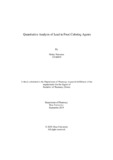Quantitative analysis of lead in food coloring agents

View/
Date
2019-09Publisher
Brac UniversityAuthor
Nowreen, NishatMetadata
Show full item recordAbstract
Lead poisoning occurs when lead builds up in the body, often over months or years. Even small amounts of lead can cause serious health problems. Children younger than 6 years are especially vulnerable to lead poisoning, which can severely affect their mental and physical development. At very high levels, lead poisoning can be fatal. The aim of this study is to find out levels of lead in food colors, which are commonly used in street food. According to WHO the maximum permissible limit of lead is 0.05 mg/L. Seven samples of food color were taken namely; S01 (green), S02 (yellow), S03 (chocolate), S04 (red), SS01 (green), and SS02 (yellow) SS03 (red). S01, S02, S03 and S04 were in solid form. Rest of the samples was in liquid form. To find the Pb levels in the samples, Direct Air-Acetylene Flame method was followed. The analysis showed that, out of seven samples, the Pb levels of four samples (S01, S02, S03 and S04) were out of limits which were respectively 0.15 mg/kg, 0.15 mg/kg, 0.15 mg/kg, and 0.10 mg/kg. Therefore, we can say that the usage of these colors can be harmful for us and cause severe toxicity.
